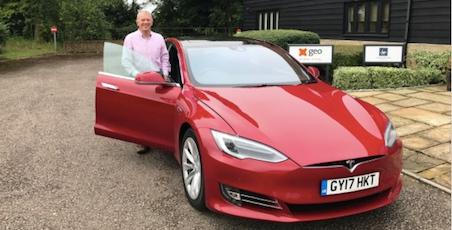
By Simon Anderson, geo — I have just taken delivery of a Tesla and it is awesome – sorry about the American vernacular but it is appropriate in this case.
I have long thought that the future of private transport is electric but this just confirms it. It is so much better than the half-way house that is a hybrid.
Earlier this month Volvo announced all new cars will be electric or hybrid from 2019. Tesla has just delivered the first mid-size saloon, the model 3. With 215 miles range, under 6 seconds 0-60 mph and seating for 5 for $35,000, this car will ramp up demand - and supply from competing car companies.
This all sounds fantastic – but there is a flaw. Charging.
I commute 50 miles a day which translates into 16kWh a day: twice my home’s daily electricity usage. Even if I was to charge at work it still doubles my home’s daily demand. What is more, there is growing interest in my village about getting an electric vehicle so I might be responsible for generating a local electricity demand “hot spot”.
And it doesn’t stop there. People at work are also getting interested and so we are planning on fitting 10 EV charging stations which will create another “hot spot” with all the cars expecting to be charged during an 8-hour work day.
The Office for Low Emission Vehicles (OLEV) and the Energy Networks Association has met to discuss how they are going to address this issue. Their current answer is some form of managed charging: in other words, the ability to interrupt your charging when there is an overload. Joined up government? On one hand, they encourage ownership with various regulatory and financial incentives whilst on the other they are looking at ways of controlling charging before it has even got going.
So here is another option: the hybrid home (or office). The home is fitted with its own battery which acts as an aggregator that balances local supply and demand – and can store solar for use later in the day. The home or office becomes an “active building” automatically integrating with the grid to manage several local issues, not just EV hot spots.
So how do we pay for it? Like other home fixtures and fittings such as boilers – on the mortgage only this installation saves money – from our analysis this can be over 1/3rd of the electricity bill. It also would lend itself to incentives such as green mortgages and a help-to-buy (energy efficient) home scheme.
E.ON has just published research that shows “that almost half of those asked would like to see solar and storage installed in the their homes by 2020”. The hybrid home brings these two elements together: it offers integrated thinking and a unified home energy management system that actively supports the grid. Now that’s joined up thinking.
Simon Anderson is Chief Strategy Officer at geo.
TriplePundit has published articles from over 1000 contributors. If you'd like to be a guest author, please get in touch!














